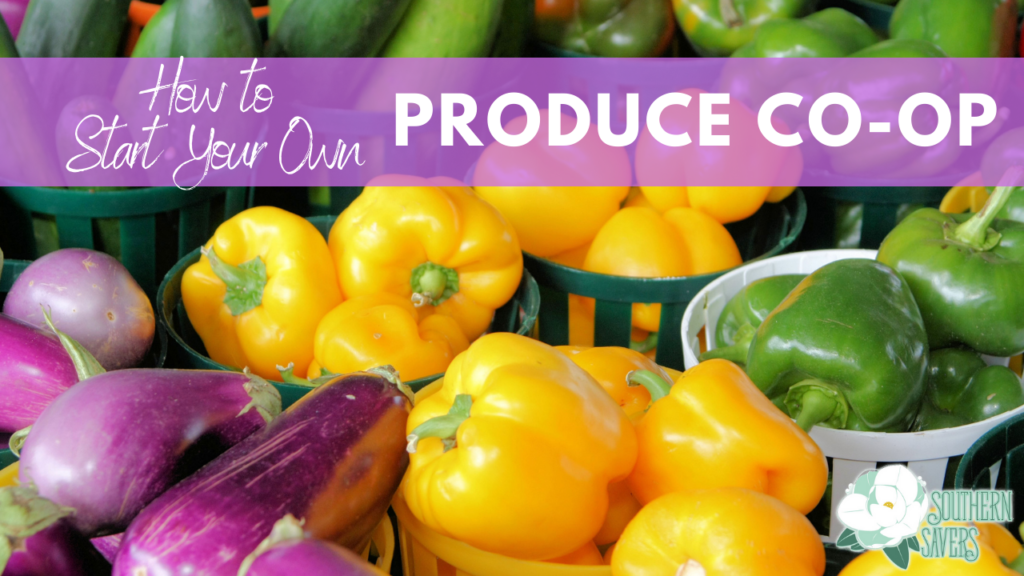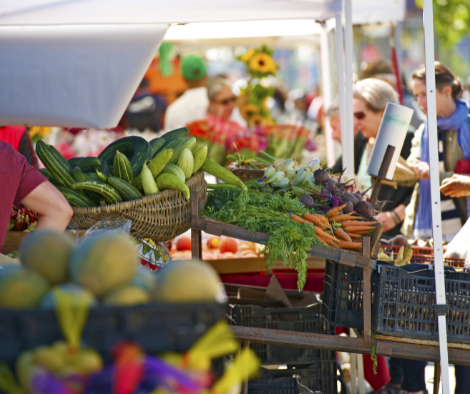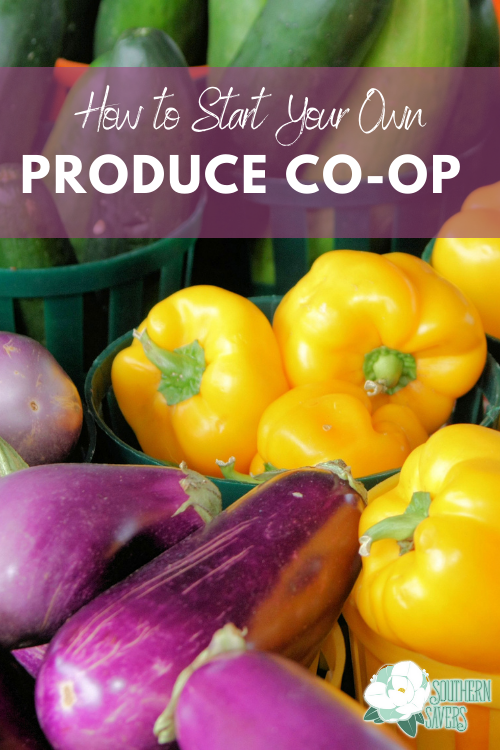This post may contain affiliate links. Read our disclosure here.

There are three rules to saving on produce, and they all kind of go together: 1) Buy in a farmers market instead of a grocery store, 2) buy in bulk, and 3) buy what’s in season. This may not sound too bad until you realize that bulk means the tomatoes come in a 25 lb box, cabbages are 20 heads per box, potatoes are 10 – 5 lb bags in a huge 50 lb bag… you get the idea. To get the best price means you are buying way more than one family needs.
There is a very easy solution, though, and that is to go in with friends and create your own produce co-op. It’s very easy to do and can be as small or as big as you like. Several years ago I interviewed a friend who started her own produce co-op, and the principles still apply! Watch the video below or read on to see more tips on how to start your own produce co-op.
How to Start Your Own Produce Co-Op
Find the largest market near you
This may seem like a no-brainer, but it’s not about the nearest market, you want to find the largest market in your area. The bigger the farmers market the more farms and vendors will be there selling their goods. It’s supply and demand and this will work to your advantage, not only will you get lower prices, but you’ll have larger selections and better quality to pick from. Here’s a list of Farmer’s Markets the government tracks.
Set your day and cost
Getting organized from the start is the best way to make this work long term. Pick one or two days a month that you will always plan to meet (our co-op is the 1st and 3rd Saturday every month). You want to plan for early in the morning, most real farmers markets are sold out and closed up by 8:30-9 am each day. If you go later in the day you aren’t buying from the farmer, but instead you are buying from a re-seller who bought from the farmer earlier this morning and is now re-selling to you (not at the best price).
Decide a set amount that everyone will chip in. We do $22 a person ($20 is for produce and $2 per basket goes towards the 5 folks that do all the shopping and organizing each week). To keep things simple and easy everyone needs to chip in the same amount. If someone wants more than others then they pay for two shares that week and bring two laundry baskets.

Plan your trip
Once you have folks that want to join together and see how much money you have to work with, you are ready to head out to shop. Before going to the market, pull up market reports that the USDA releases every morning showing what is on sale at the market today and how much it was selling for. This is your homework and will save you a lot of time and money tomorrow. While the USDA is only tracking the 19 large “Terminal Markets” in the US it will still show you what will be at your market and the prices should be very similar.
With this report you can see what to expect at the market tomorrow and the price to expect to pay. Make a plan now of what typs items you would like (ask others in your group too). Now you will know how many cases to grab and how far your money will go when you get to the market.
Tip: Most farmers markets deal only in cash so be prepared.
Go shopping
Go as early as possible. Be there when they open (for ours it’s 5:30 am). The first shoppers get the best selection and also tend to get the best prices. Have your plan of what to look for and general price ideas on a piece of paper with you and be ready to make a deal as you go. Depending on how many people you are shopping for, you might need to take a truck or trailer to haul items.

Our co-op has around 50-100 baskets each time, this not only gives you a lot of buying power, but it also means you will need people with trucks! This picture was one of two trucks worth for a few weeks ago.
Note: You can be as big or as small as you like. Inviting everyone you know gives you more money to work with to get more items, but just having 4 friends will work too.
Meet & Sort
Find a church parking lot or someone’s yard that you can meet at and sort items. Have everyone bring a laundry basket for their share (if they are paying for two shares then two baskets). Put names on each basket and line them up so you can quickly put items in each basket.

If someone forgets their basket then use some of the cases that things came in as a box for them so you can get started. This also works great for folks who are late.
Put one item in each box and remember to do heavier items first. No one wants their bananas at the bottom of the box!
Have an exchange table
There are lots of picky eaters in the world so have a table off to the side to exchange items. This is done AFTER all the baskets have been sorted. Everyone starts off getting everything, then if they want to swap with others they can if folks are willing. No you can share all the okra with me and I’ll give you all my mushrooms!
Come home and enjoy
Most of the items in your co-op basket will last a while, they are much more fresh than what you find in the grocery store. If you don’t think you’ll eat them right away though, go ahead and get them in the freezer so you don’t waste money. I also start googling recipes to use up items I might not normally get. Last week we got mushrooms, which I don’t eat, and we realized there was one thing that we do eat mushrooms in… Cream of Mushroom soup that goes in my Sunday roast and various casseroles. So we made homemade Condensed Cream of Mushroom soup and have enough for probably 10 dishes now!
Whether you do a co-op or not, here are some tips for the farmers market!



